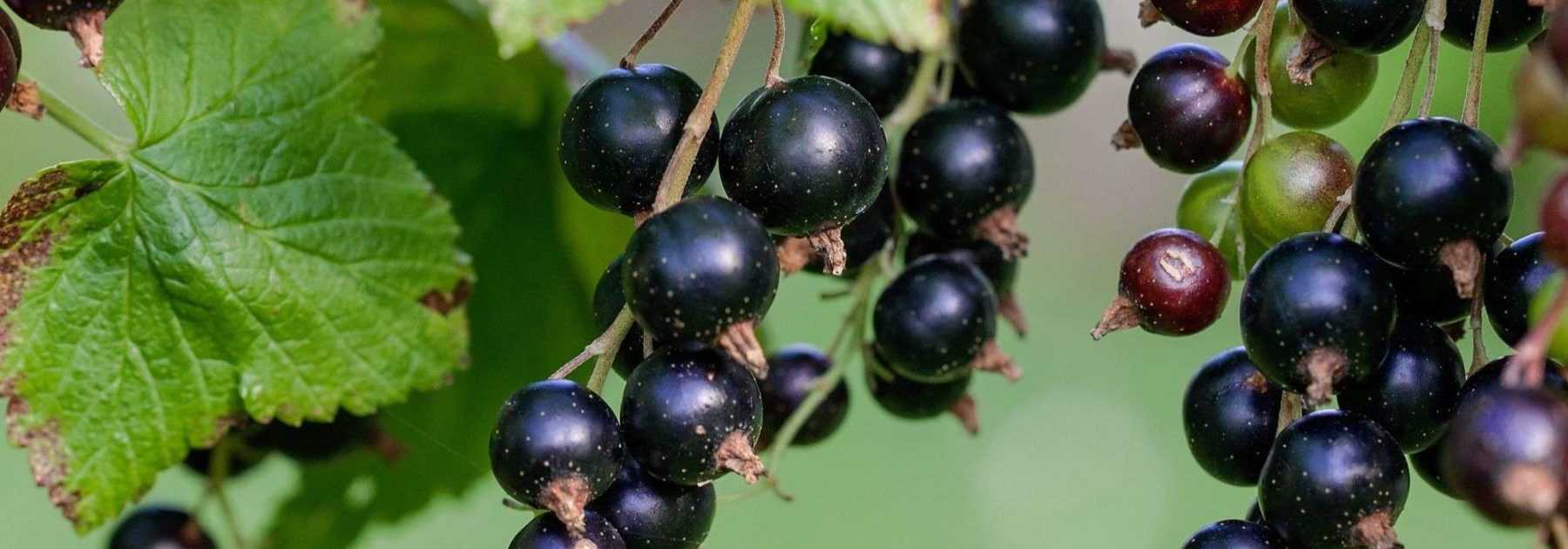
Blackcurrant Bush: Planting, Pruning and Care
Contents
The blackcurrant bush, in a few words
- Blackcurrant bushes are deciduous bushes closely related to redcurrants, very hardy and long-lived, with aromatic foliage and edible berries.
- They produce tangy, slightly sharp black berries called blackcurrants, perfect for pies, syrups or jellies, rich in iron, calcium and vitamin C.
- Plant them in fresh, preferably acidic soil rich in organic matter.
Our expert's word
The Blackcurrant, also known as Blackcurrant Bush – Ribes nigrum – is part of the classic small fruit range, with its tangy and slightly sharp black berries recommended for improving vision (myopia, eye fatigue, cataracts) thanks to its anthocyanins and vitamin C content, much like blueberries. In the garden, it is often paired with redcurrants, to which it is closely related, and with blueberries if the soil is acidic, as their cultivation is quite similar. You can create medium-sized hedges that are both decorative and productive, reaching about 1.50 to 1.80 m in height. A blackcurrant plantation typically yields fruit for over 12-15 years if you ensure good air circulation within the bush and rejuvenate the branches, which often grow from the base but can also emerge from a 1 m stem after grafting the variety onto Ribes aureum, the golden currant.
Like redcurrants, blackcurrants thrive in cool environments and are very hardy. Maintenance is straightforward: a regular application of compost or organic fertiliser in autumn or spring, as the plant has high potassium and nitrogen needs, keeping the soil moist with mulch (wood chips or other materials), watering during prolonged dry spells, and controlling weeds that may compete with its shallow roots. Gradually renewing the branches is recommended to maintain good production levels: simply cut the 2-3 oldest stems at the base in rotation, as flowering occurs mainly on 2- and 3-year-old growth.
These bushes dislike drought due to their shallow root system, but they can thrive in partial shade in southern regions.
Description and botany
Botanical data
- Latin name Ribes nigrum
- Family Grossulariaceae
- Common name Blackcurrant
- Flowering from April to May
- Height between 1.20 to 2 m
- Exposure non-scorching sun or partial shade
- Soil type any loose soil, fresh and well-drained, not too chalky.
- Hardiness Excellent (-25 °C)
The blackcurrant, commonly called “blackcurrant” or “black gooseberry”, is one of the approximately 200 species of the genus Ribes which largely constitutes the Grossulariaceae family. This family includes, depending on classifications, the genera Itea, Escallonia and Ribes or Grossularia and Ribes. Its specific name nigrum simply means “black” in Latin, like the colour of its berries, as opposed to rubrum (“red”), which designates the redcurrant with its red berries. The gooseberry bears the scientific name Ribes uva-crispa. Other non-European species, mainly interspecific hybrids, are classified among blackcurrants, such as Ribes americana and Ribes x nidigrolaria (jostaberry). Other species are grown for ornamental purposes, such as Ribes sanguineum, one of the first shrubs to flower in spring with its generous clusters of pink flowers, or Ribes odoratum with its delicate-scented yellow flowers and highly aromatic foliage reminiscent of cloves. The foliage generally takes on beautiful autumn colours if the climate suits it well.
Blackcurrants are deciduous bushes native to Europe and temperate Asia, inhabiting fresh woodlands from the Pyrenees to Central Asia. Their cultivation began in the 16th century. Ribes all produce juicy white, red, purple, green or black berries, generally edible even if their flavour is not always remarkable. The branches and fruits are sometimes armed with prickles, but this is not the case with blackcurrants. The latter forms a vigorous, bushy shrub ranging from 1.20 to 2 m in height. When you break the branches, you notice a thick pith. The buds are small and very pointed, sometimes nibbled by birds in winter.
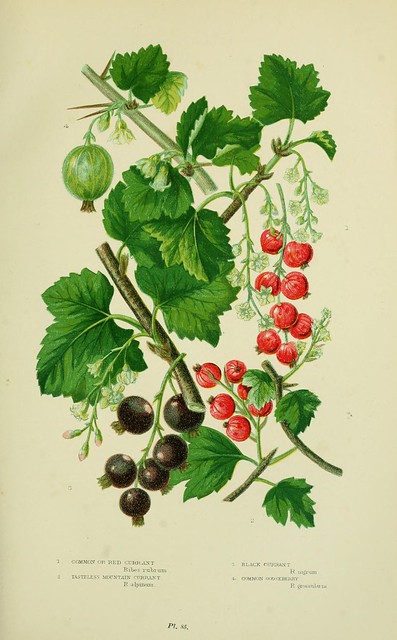
Ribes nigrum – botanical illustration
The plant forms long branches adorned with short shoots that are destined to bear flowers and fruits. The bush reaches maturity in 3 years. The leaves, fruits and buds are intensely fragrant, due to the presence of glands containing essential oils, used in perfumery. The bark is smooth, shiny, reddish-brown.
The alternate leaves have 3 to 5 crenate lobes and are attached to the stems by a pubescent petiole almost as long as the lamina. The glabrous foliage, 6 to 10 cm long, is dark green, paler on the underside, which turns yellow in autumn before falling. It releases an aromatic fragrance when crushed, which can be used to make herbal teas.
Flowering in April-May remains fairly discreet and takes the form of long pendulous clusters of campanulate yellowish flowers. They are hermaphroditic but often require another compatible variety to fruit well. However, varietal improvement has made it possible to create self-fertile blackcurrants. Pollination by insects produces small globular black berries, about 1 cm in diameter, two months later. The berries retain the dried calyx at their tip. Harvesting takes place between June and August, depending on the variety. The flavour of blackcurrants makes them difficult to eat raw, except when mixed with strawberries and raspberries. However, the recent ‘Noiroma’ variety offers large, particularly sweet and sugary fruits.
The extraction of essential oil from the buds is used in perfumery, while blackcurrant berries are mainly offered as processed products such as jellies, tarts, sorbets and syrups or liqueurs. Its acidity will be tempered by the sugar of raspberries or strawberries. Blackcurrants are the richest European fruit in vitamin C (200 mg/100 g), and also contain iron, calcium, vitamins E, A and B and anthocyanin pigments, which are beneficial for combating myopia, eye fatigue and skin ageing. The tannic acid that gives it its astringency acts against cardiovascular diseases.
Read also
Pruning Redcurrants and BlackcurrantsThe main varieties of blackcurrant

Blackcurrant Andega - Ribes nigrum
- Flowering time May, June
- Height at maturity 1,50 m
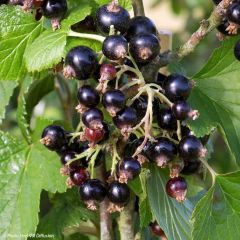
Blackcurrant Noir de Bourgogne - Ribes nigrum
- Flowering time May, June
- Height at maturity 1,50 m
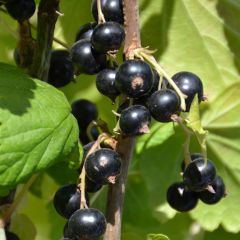
Blackcurrant Perles d'Auvergne - Georges Delbard
- Flowering time May
- Height at maturity 1,20 m
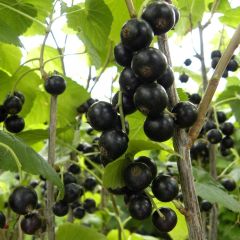
Blackcurrant Giant Boskoop - Ribes nigrum
- Flowering time May, June
- Height at maturity 1,30 m
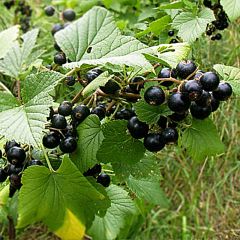
Blackcurrant Wellington - Ribes nigrum
- Flowering time May
- Height at maturity 1,50 m
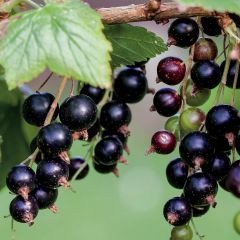
Blackcurrant Black Down - Ribes nigrum
- Flowering time May
- Height at maturity 1,50 m
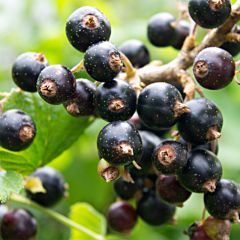
Blackcurrant Titania - Ribes nigrum
- Flowering time May
- Height at maturity 1,50 m
Discover other Blackcurrant bush
View all →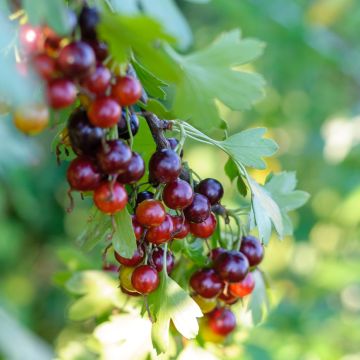
Available in 6 sizes
Available in 2 sizes
Available in 1 sizes
Available in 1 sizes
Available in 1 sizes
Available in 3 sizes
Available in 1 sizes
Available in 1 sizes
Available in 3 sizes
Planting
Where to plant blackcurrant?
The blackcurrant has excellent hardiness (-25°C) and prefers regions north of the Loire or in mid-mountain areas. However, it is sensitive to prolonged cold between 1 and 5°C which can lead to fruit drop due to poor fertilization. In the south, give it a semi-shaded and cool spot rather than full sun.
It is content with ordinary, deep, humus-bearing soil without too much lime, cool in summer but well-drained, even though it tolerates heavy clay soils.
Choose a spot with indirect sun or partial shade, in a location sheltered from strong winds. The blackcurrant indeed dislikes heat and drought.
If possible, alternate several varieties of blackcurrants to encourage pollination even for self-fertile varieties. Allow one pollinator for every four young plants.
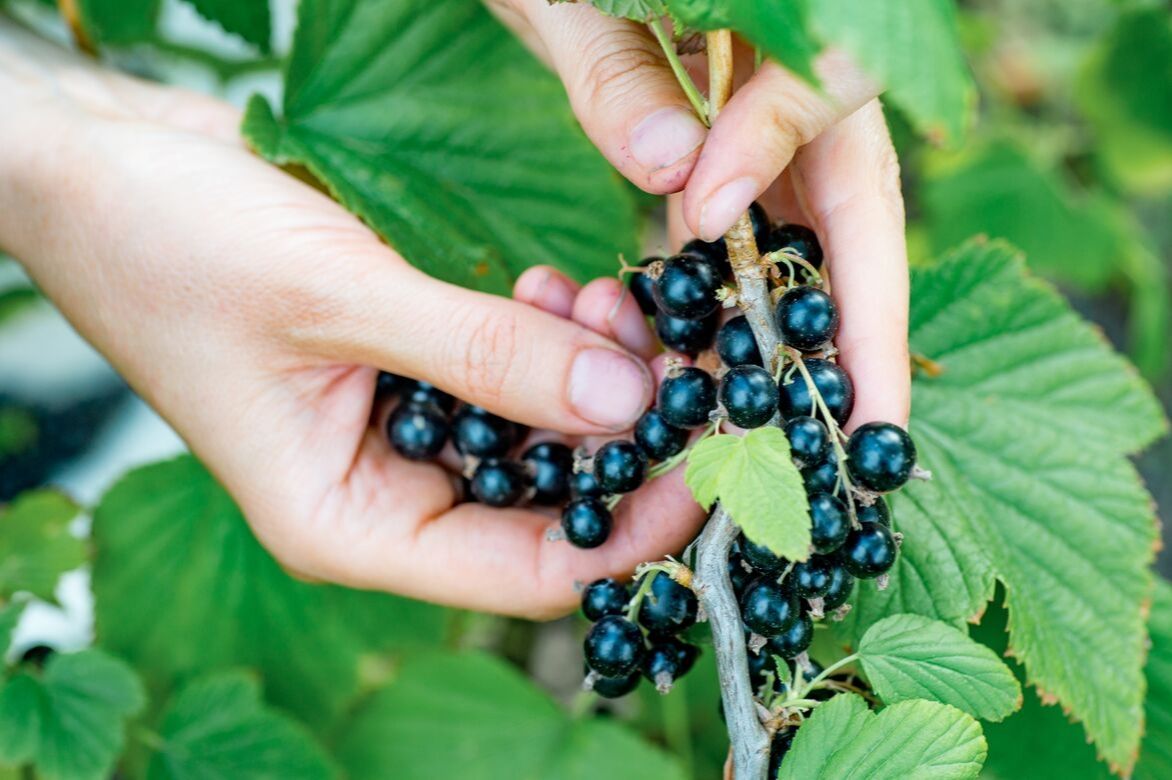
When to plant?
Planting is recommended between October and March when the foliage is absent, avoiding frost periods.
How to plant?
This plant is very easy to grow, especially if placed in cool conditions sheltered from wind and scorching sun. Allow spacing of 1.50 to 1.80 m if forming a hedge.
- For a container-grown young plant, soak the root ball in a bucket of water to moisten it thoroughly. If it’s a bare-root young plant, trim any damaged roots cleanly and coat them with praline or, failing that, mud.
- Using a spade, dig a hole 30 cm in all directions, avoiding smoothing the walls.
- Prepare the soil by removing stones and weeds,
- Add a good amount of well-decomposed organic matter (compost, manure…). In poor soil, add crushed horn (rich in nitrogen), base fertiliser (rich in phosphorus and potassium). If your soil is chalky, add turf and plan for an acidic mulch (pine needles or bark…).
- Bury the blackcurrant’s collar 5 cm deep to encourage new stem growth, then backfill with soil, forming a basin.
- Pour a full watering can to settle the soil and remove air pockets.
- Remember to cut back the clump to 2-3 buds if this hasn’t been done at the nursery.
In pots: place a layer of gravel or clay pebbles at the bottom of a deep pot to facilitate drainage.
Fill the pot with a mixture of compost, garden soil and well-rotted manure.
Read also
How to dry blackcurrant leaves?Pruning, care, potential diseases
Pruning Blackcurrant Bushes
The aim is to obtain and maintain around a dozen productive stems per plant. To achieve this, it is advisable to cut back the stems to 2-3 buds in the planting year. Renewal of the oldest stems (5-6 years) begins after 3 years and continues for over 15 years for optimal production. Carry out pruning in winter or just after the harvest.
To learn more, visit this guide: Pruning Redcurrants and Blackcurrants
Maintenance
- Apply organic fertiliser annually at the start of the growing season to support fruit production and plant health.
- Maintain soil moisture with regular watering, especially in spring, to prevent rust.
- Low temperatures between 1 and 5°C affect flower fertilisation during flowering, which can lead to fruit drop. Use a winter fleece during cold nights if necessary.
- Install a protective net against birds before the fruits turn red, or better yet, provide a dish of water for the birds.
- In autumn, remove dry or spotted leaves.
This accommodating bush is not very susceptible to diseases. However, it has a few enemies, such as aphids, scale insects, and mites, whose overwintering forms can be destroyed with a winter treatment. The currant clearwing moth is a white caterpillar that burrows into blackcurrant stems between June and October. Cut and burn affected stems. If rust (orange pustules on the underside of leaves) appears, spray with a fungicidal treatment such as horsetail decoction. Avoid the presence of five-needle pines (Weymouth pine) within 1 km and sedges (Carex), which transmit this disease. Anthracnose appears in June-July as angular white spots edged with reddish-brown, accompanied by premature leaf drop or even drying of clusters. Collect and burn fallen leaves, apply a fungicidal treatment (copper) at the end of flowering, 15 days later, and a third after the harvest.
Abnormally swollen buds that dry out or produce plicate leaves indicate an attack by blackcurrant gall mite, which can transmit the incurable Blackcurrant Reversion virus. Remove and burn affected buds. Uproot the plant if it is too weakened.
If hungry birds attack buds in winter, offer them seeds instead.
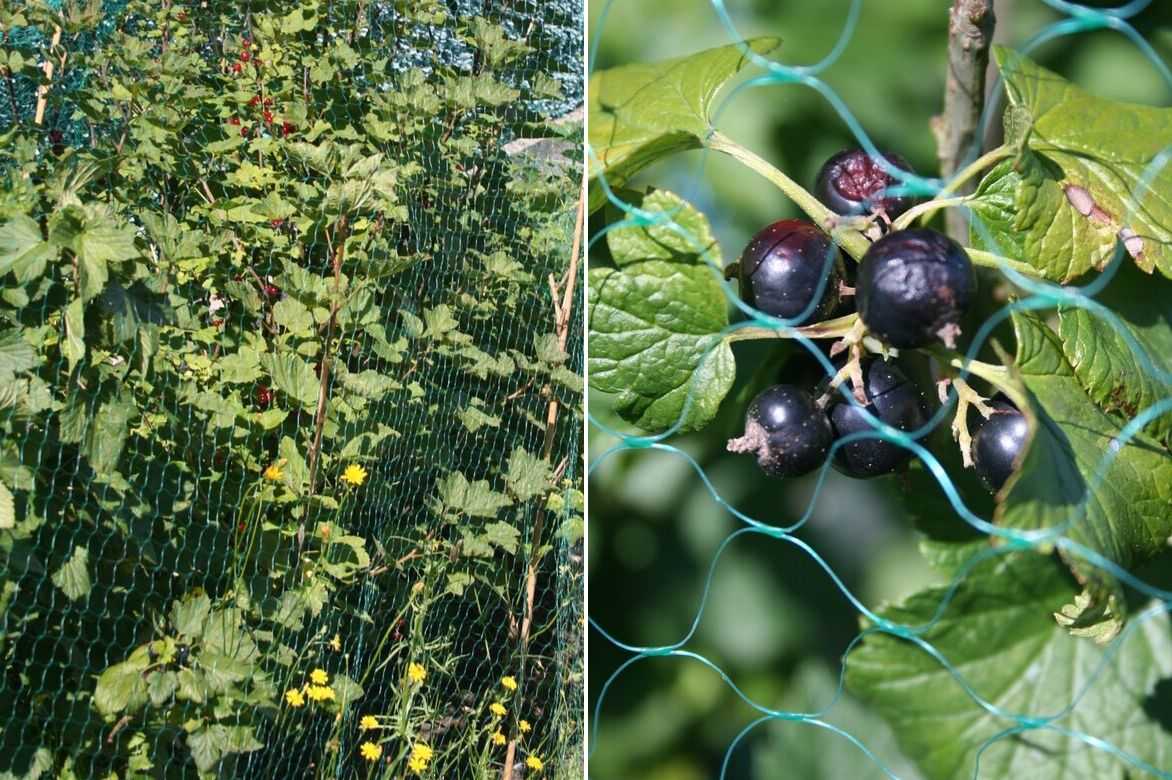
Installing a protective net
Harvest and storage
Harvesting Blackcurrants
- Pick the entire cluster after checking that the berries at the base, which ripen later, are mature as the fruits must have reached perfect ripeness. As soon as the first fruits begin to fall, you must act quickly. The harvest takes place in late June-July or even August-early September with late varieties like Tsema or Jet or if the climate is cold. A mature plant produces between 2 and 4 kg of fruit.
- In the morning or late afternoon, when there is no rain, use a comb to drop the clusters or berries into a basket lined with a cloth and place them quickly in a cool spot.
- Rinse them briefly under cool water before eating, freezing them well spread out on a tray, or processing them.
Storing Blackcurrants
- Blackcurrants can be stored in the vegetable drawer of the fridge for up to 1 week. They can then be eaten in salads, to decorate cakes or ice creams. They can be paired with meats like beef or game, or used to make muffins, tarts, etc.
- Processing them into jams, jellies, juices, coulis, ice creams or syrups is, of course, essential.
- Don’t forget to use the blackcurrant foliage, which can be used to flavour wines and liqueurs after maceration.
Propagation: Taking Cuttings from Blackcurrant
Propagation by cuttings is carried out from late August to October or in March.
Propagation by cuttings
- Take cuttings of about 20 cm from semi-hardened or hardened shoots depending on the chosen season, with at least 4 buds.
- Place the cuttings directly in position in groups of 3 or in a small trench, in light, fresh soil and in partial shade. Leave only 2 buds exposed.
- Ensure the soil remains moist during the summer.
- Transplant the rooted young plants after one year if necessary.
Uses and Associations
In the garden, create a small edible hedge by mixing Blackcurrant bushes, Redcurrant bushes and Raspberry bushes, for example along the edge of a vegetable patch, or plant the Blackcurrant bush among flowering bushes or at the back of a perennial border made up of Japanese anemones, Hostas or Heucheras.
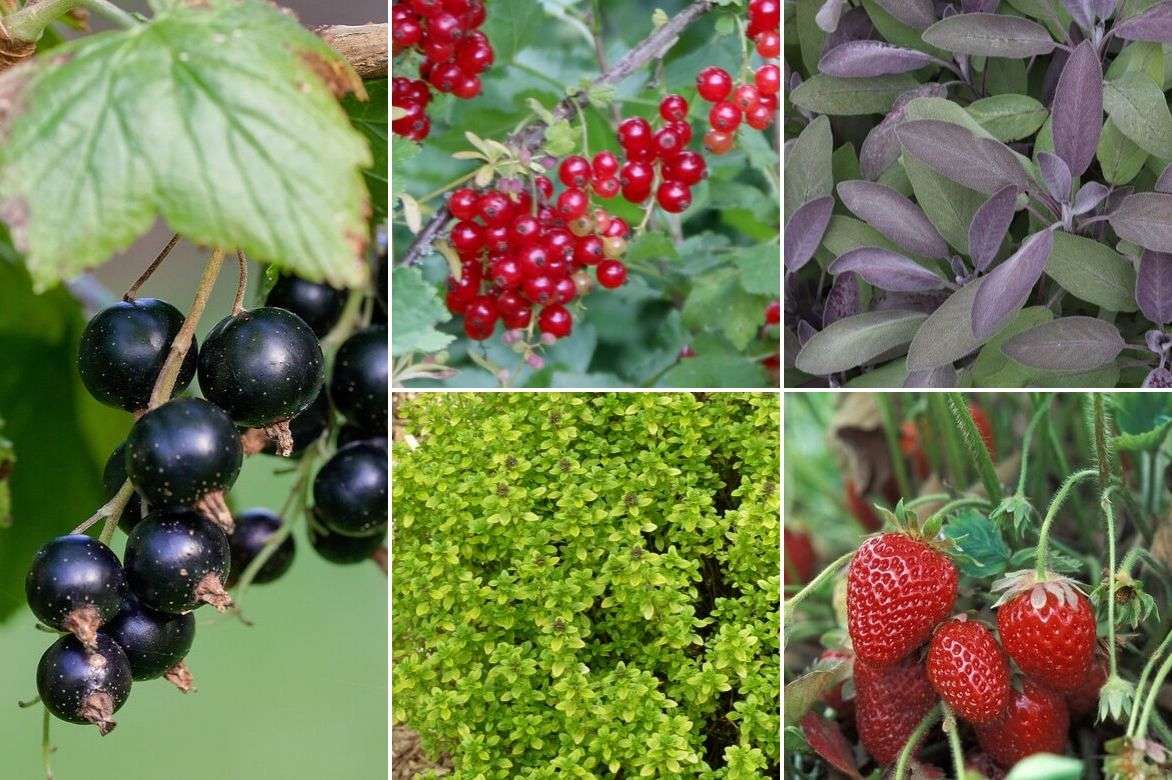

Another planting idea: blackcurrant bush and redcurrant bush accompanied by some strawberry plants at their base. You could add aromatic plants (thyme, sage…) which attract pollinating insects that will also pollinate your fruit bushes
The blackcurrant bush adapts well to growing in a deep pot but should be planted alone in its container.
To go further
Discover:
- Our range of blackcurrant bushes and Our 2025 new berry varieties
- Our tutorial: How to dry blackcurrant leaves?
- Our advice sheet on Blackcurrant bushes: diseases and parasitic pests
- Advice sheet: 5 red berries for beginners
- Pascale explains how to choose the ideal blackcurrant variety
- Subscribe!
- Contents
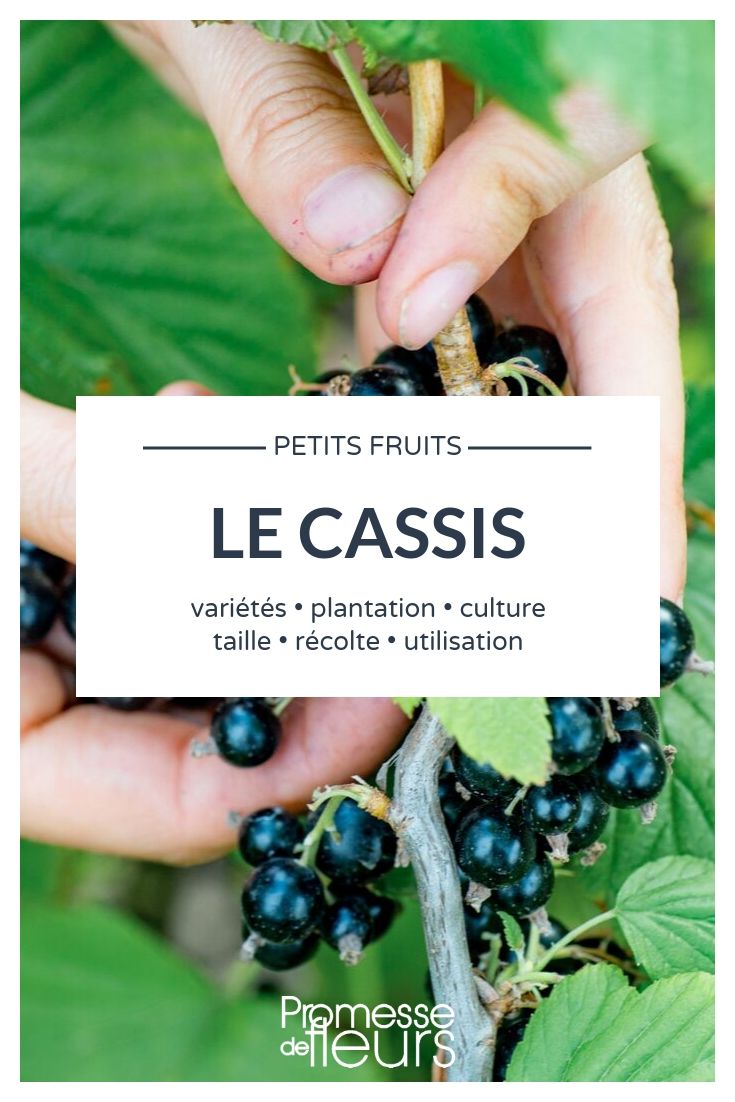



































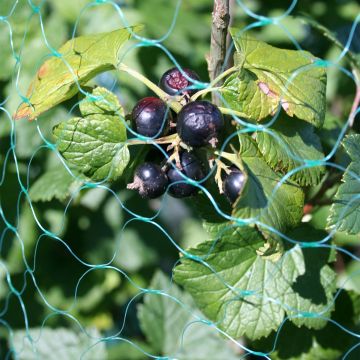
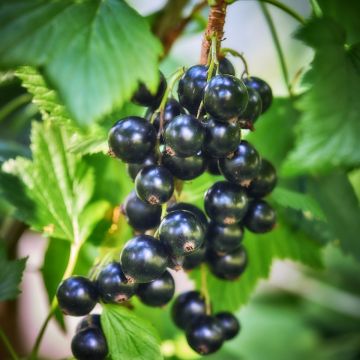
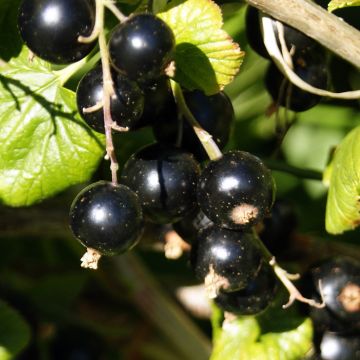




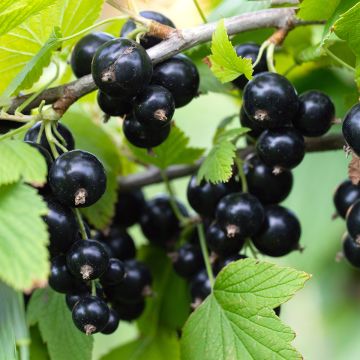
Comments